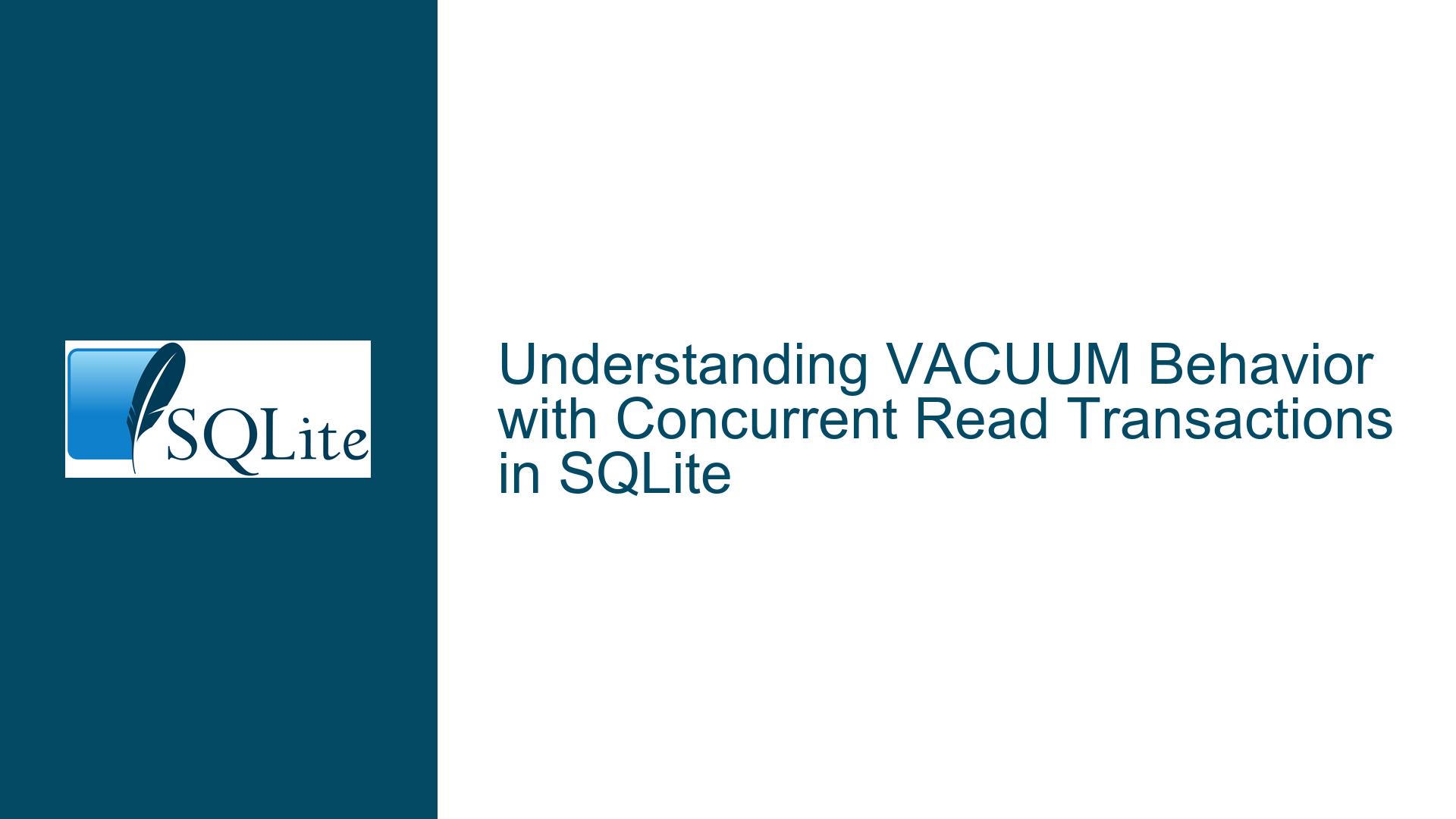VACUUM Behavior with Concurrent Read Transactions in SQLite
VACUUM and Concurrent Transactions: Documentation vs. Behavior
The core issue revolves around the behavior of the VACUUM command in SQLite when concurrent read transactions are present. The documentation explicitly states that VACUUM will fail if there is an open transaction on the database connection attempting to run the VACUUM. However, empirical testing reveals that VACUUM does not always fail immediately in the presence of concurrent read transactions. Instead, it may wait for the read transaction to complete before executing. This discrepancy between the documented behavior and observed behavior raises questions about the conditions under which VACUUM fails or waits, and how developers should interpret and handle these scenarios.
The documentation’s statement is clear but leaves room for interpretation. It does not explicitly distinguish between read and write transactions, nor does it specify whether the failure is immediate or conditional. This ambiguity is further complicated by the fact that SQLite’s behavior can vary depending on factors such as the number of connections, the type of transactions, and the use of pragmas like busy_timeout. Understanding these nuances is critical for developers who rely on VACUUM for database maintenance, as misinterpreting the behavior could lead to unexpected failures or performance bottlenecks.
Why VACUUM Might Fail or Wait: Transaction Types and Connection Contexts
The behavior of VACUUM in the presence of concurrent transactions depends on several factors, including the type of transaction (read or write), the number of database connections, and the configuration of SQLite’s locking mechanisms. To understand why VACUUM might fail or wait, it is essential to examine these factors in detail.
First, SQLite uses a file-level locking mechanism to manage concurrent access to the database. When a transaction is active, SQLite acquires a lock on the database file to ensure data consistency. The type of lock acquired depends on the transaction type: read transactions acquire a shared lock, while write transactions acquire an exclusive lock. The VACUUM command requires an exclusive lock on the entire database file to reorganize and optimize the database. If any other transaction holds a lock, VACUUM must either wait for the lock to be released or fail immediately.
The documentation suggests that VACUUM will fail if there is an open transaction on the same database connection. However, this does not account for scenarios where multiple connections are involved. In a single-connection scenario, if a read transaction is active, VACUUM cannot proceed because the connection already holds a shared lock. In this case, VACUUM will fail immediately, as demonstrated by the error message: Runtime error near line 2: cannot VACUUM from within a transaction.
In a multi-connection scenario, the behavior of VACUUM depends on the type of transactions and the configuration of SQLite’s busy timeout. If a read transaction is active on another connection, VACUUM may wait for the transaction to complete if a busy timeout is configured. The PRAGMA busy_timeout setting determines how long SQLite will wait for a lock to be released before giving up. If no busy timeout is set, VACUUM may fail immediately if it cannot acquire the necessary lock.
The observed behavior in the test case, where VACUUM waits for a concurrent read transaction to complete, suggests that the database connection had a busy timeout configured. This allowed VACUUM to wait for the shared lock to be released rather than failing immediately. However, this behavior is not guaranteed and may vary depending on the SQLite version and configuration.
Resolving VACUUM Issues: Best Practices and Configuration Tips
To ensure that VACUUM operates as expected, developers must carefully manage transactions and configure SQLite’s locking behavior. Below are detailed steps and solutions to address the issues related to VACUUM and concurrent transactions.
1. Ensure No Active Transactions on the Same Connection
The most straightforward way to avoid VACUUM failures is to ensure that no transactions are active on the same database connection when VACUUM is executed. This can be achieved by explicitly committing or rolling back any open transactions before running VACUUM. For example:
BEGIN;
-- Perform read operations
COMMIT; -- Ensure the transaction is closed
VACUUM;
If a transaction is left open, VACUUM will fail with the error cannot VACUUM from within a transaction.
2. Use Multiple Connections Wisely
When using multiple database connections, ensure that VACUUM is executed on a connection that does not have any active transactions. If other connections have active read transactions, VACUUM may wait or fail depending on the busy timeout configuration. To minimize conflicts, consider running VACUUM during periods of low database activity or temporarily disabling other connections.
3. Configure Busy Timeout
The PRAGMA busy_timeout setting can be used to control how long SQLite waits for a lock to be released before giving up. Setting a busy timeout allows VACUUM to wait for concurrent read transactions to complete rather than failing immediately. For example:
PRAGMA busy_timeout = 30000; -- Wait up to 30 seconds for a lock
VACUUM;
This approach is particularly useful in multi-connection scenarios where read transactions may be active for extended periods.
4. Schedule VACUUM During Maintenance Windows
To avoid conflicts with concurrent transactions, schedule VACUUM during maintenance windows when the database is not in use. This ensures that VACUUM can acquire the necessary locks without waiting or failing. For example, you can use a script to temporarily disable access to the database, run VACUUM, and then re-enable access.
5. Monitor and Retry VACUUM
In scenarios where VACUUM may fail due to concurrent transactions, implement a retry mechanism to handle transient failures. For example, you can use a loop to attempt VACUUM multiple times with a delay between attempts:
PRAGMA busy_timeout = 10000; -- Wait up to 10 seconds for a lock
ATTEMPT_VACUUM:
BEGIN;
VACUUM;
COMMIT;
-- If VACUUM fails, retry after a delay
This approach increases the likelihood of VACUUM succeeding without requiring manual intervention.
6. Consider Alternative Maintenance Strategies
In some cases, VACUUM may not be the most efficient way to maintain the database. For example, if the database is frequently updated, consider using PRAGMA auto_vacuum to enable incremental vacuuming. This reduces the need for full VACUUM operations and minimizes conflicts with concurrent transactions. Alternatively, you can use ANALYZE to update statistics without reorganizing the database.
By following these best practices and configuration tips, developers can ensure that VACUUM operates reliably and efficiently, even in the presence of concurrent transactions. Understanding the nuances of SQLite’s locking behavior and transaction management is key to avoiding unexpected failures and optimizing database performance.






